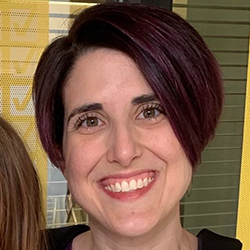Gina Passante
Physics Education Research (PER) Professor
Why Physics?
A PhD in quantum computing
Gina first fell in love with physics in high school and carried this love into the college setting. Undergraduate research cemented this interest, and she completed a bachelor’s degree in physics so she could deepen her learning of physics. But she didn’t yet know where she wanted this to lead. During graduate school, she studied quantum computing. However, she says, “while I was fascinated by the science I was doing, I couldn’t envision doing that work for the rest of my career. I found myself more interested in the learning process and how people think about quantum mechanics.”
Transitioning to physics education research (PER)
During her PhD, Gina started reading papers in PER and decided this is where she wanted to go. She dabbled in PER, conducting teacher training for graduate students, engaging in educational programs, and went to physics education conferences. She found it very satisfying to think about physics concepts at a deeper level. After her degree in quantum computing, she was accepted for a postdoctoral position in PER where she studied student learning of quantum mechanics and developed tutorials to improve instruction.
Studying the teaching and learning of quantum computing
As a physics professor, Gina has continued to study student learning, focusing on quantum computing. “My desire to understand how students learn and to use that knowledge to improve instruction is rooted in the belief that physics should be accessible to anyone interested in learning it,” she says.
Using Physics and PER
Thinking deeply about physics
Gina’s position involves both teaching and research, and she continues to enjoy conducting research in PER. “I would miss the intellectual part of research if this wasn’t part of my job,” she says. Gina finds her research rich and satisfying because she thinks deeply about physics, both as a teacher and as an education researcher. “I get to think about the original theory in a way I hadn’t thought about it before,” she says, rather than the fine details. “That’s my favorite part of my job.”
PER informs my teaching
Because of studying PER, Gina feels that she’s better informed about what makes a good classroom experience, and what students are thinking. “I’m more tuned in.”
Collaboration made it possible
Gina feels her pathway was possible because of her friends and colleagues. Collaboration made the work more fun and enabled her to thrive. She tries to build community and camaraderie in her classroom to support the same experiences for her students.
Advice for Students
Learn about PER
For those interested in PER and teaching careers, Gina suggests going to talks, and reading as many things as you can. Reach out to people who are working in areas that are interesting to you. “PER is a broader field than I realized when I started,” she said. “I read papers in the area I was interested in, talked to those people, and thankfully they hired me.”
Reach out to people in PER
In order to transition from quantum computing to PER, Gina connected with the PER community. Her graduate advisor paid for her to attend the American Association of Physics Teachers (AAPT) summer meeting and meet people. “I needed to show that I was serious,” says Gina. AAPT is where she made the professional connection leading to her postdoctoral position. “Reach out to people, meet face to face,” Gina advises. “The whole community was so nice, I met everybody in the field at that conference.”
PER isn’t easier, it’s different
Gina wants students to know that a career in PER isn’t an easier path than other physics subfields, it’s a different path. It’s still hard and rigorous, and you need to make sure it’s your passion. Just like most physics subfields, there are more people interested in PER than faculty jobs.
Graduate school is not the only option
Gina says, “When students ask for advice on whether or not to go on to graduate school, I always ask them why they want to go. What is it that draws them to a career in physics?” Graduate school is not the only option; it is only for those who really want to pursue that path.
The road to a faculty career isn’t easy
“Expect a long and sometimes difficult road towards a faculty position,” says Gina. “And that road will often be bumpy and will almost certainly have unexpected twists and turns. I worked hard when studying physics; I ultimately did very well, but not without an extraordinary effort. I almost quit more times than I can count.” She wants students to know they aren’t alone if the going is tough. She also counsels students to consider positions at a variety of institutions; don’t discount a position because it’s at a two-year college or lower prestige institution; “you can do good work everywhere.”
About Gina

Interesting Highlights
- Career path from quantum computing to physics education research
- Now studies student learning
- Enjoys fiber arts and watercolors
- Has two young daughters
Advice for Students
- Learn about PER
- Reach out to people in PER
- PER isn’t easier, it’s different
- Graduate school is not the only option
- The road to a faculty career isn’t easy
